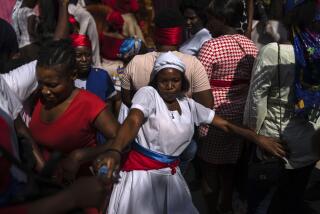Afro-Cuban Religion Thrives in Tough Times : Culture: Economic hardship and Communist government’s new openness toward faiths contribute to growth among <i> santeria</i> followers.
- Share via
HAVANA — Cubans and tourists alike are flocking to santeria, an Afro-Cuban religion that promises help with sickness, love and jobs at a time when the Communist-ruled island faces growing economic hardships.
Many of the new santeria followers are Cuban professionals and intellectuals, according to local priests of the rite, who are known as babalawos.
“Being a santero has become very fashionable these days,” one University of Havana professor said.
The religion blends the worship of Roman Catholic saints with ancient African Yoruba beliefs originally brought to the Caribbean by black slaves shipped from West Africa by Cuba’s Spanish colonial rulers.
Santeria survived the political and economic upheavals of Cuba’s 1959 revolution, and along with mainstream religions is now benefiting from the Communist government’s policy of greater openness toward religion.
It has also become a hard currency-earner for the cash-starved nation, attracting academics, foreign santeros and tourists curious to watch santeria rites and buy souvenirs.
“The government no longer looks down on it, and it’s become quite a moneymaker because of all the people in Miami who come here for initiation as priests,” said the Cuban professor, who asked not to be identified.
The religion received an official stamp of approval when Cuba recently hosted a first-ever conference for some 100 santeria scholars from Cuba, Venezuela, Nigeria and the United States.
Flying in from Miami, two American santeros arrived loaded down with bags of special clothing, feathers and other gear for private initiation ceremonies in which devotees submit to the power of one of the santeria deities, known as orishas.
An initiation in Cuba is not only considered more authentic, it costs much less than the thousands of dollars charged by U.S. babalawos.
The exact number of santeria followers in Cuba is impossible to pin down because of the religion’s lack of formal structure. Cuba’s Academy of Sciences estimates there are at least 15,000 practicing babalawos among the island’s nearly 11 million residents.
Followers believe the babalawos can obtain favors from more than a dozen gods, often by sacrificing small animals such as chickens, pigs or lambs. A complicated system using tiny sea shells, coconut chips, small stones, plant seeds and animal bones is used to divine a particular god’s wishes.
Obtaining sacrificial animals is now much more difficult in Cuba. Shortages and government rationing of food have become more acute following the collapse of trade ties with Eastern Europe and the former Soviet Union.
“It’s harder to get animals, but not impossible,” said one Havana psychiatrist who is also a santeria priest. “Usually someone knows a farmer who has a rooster or can get one.”
White-clad babalawos with colorful bead necklaces and feathers pinned to their caps are quite a common sight on the streets of Havana.
Apartment windows left open to catch a cooling breeze often provide a glimpse of tiny homemade shrines inside that honor one or another of the santeria gods. Some devotees also proudly display dolls dressed in the favorite colors of a particular deity and perched in a comfortable chair.
For Cubans weary of long lines to buy food and the government’s tight control of dissident views, santeria offers temporary escape and a source of spiritual nourishment.
The religion, which for decades was considered benign folklore practiced by poorer families, is now attracting dedicated followers among medical doctors and even scientists.
Dr. Juan Dieguez, a Havana obstetrician, finishes his hospital rounds late in the afternoon, then rushes home to treat santeria clients.
“Sometimes doctors do not know what to do with a patient,” Dieguez said. “There can be different kinds of treatments, both medical and through gifts to the gods.”
He told of a small girl who came to him after dermatologists were unable to halt a fast-growing skin disease that threatened to impair one of her eyes. After interpreting a message from the santeria gods, Dieguez said, he treated the child with a herbal plant, and she recovered in three days.
“We only use our religion to help people,” he said, “never to harm them, or we will be harmed.”
The exoticism of santeria has not been lost on the Cuban government. Badly in need of dollars to buy oil, food and machinery, it has seized on the ritual as a cultural attraction to market to tourists.
Tourists in Havana can sign up for an escorted evening visit to a santeria ceremony, buy unblessed necklaces in the color of their favorite deity and take home videotapes about the religion and its powerful music.
One of the best-selling books in Cuba for the past year has been “Los Orishas en Cuba,” a study of santeria written by Natalia Bolivar and prominently displayed in tourist shops.
“We don’t really mind the commercialization of our religion,” said one santeria priest. “But I get upset when they sell T-shirts to tourists with a picture of a god in what are another god’s colors.”
More to Read
Sign up for Essential California
The most important California stories and recommendations in your inbox every morning.
You may occasionally receive promotional content from the Los Angeles Times.












